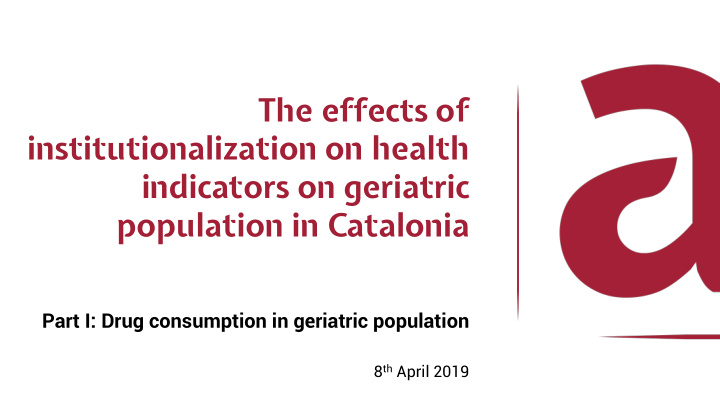



The effects of institutionalization on health indicators on geriatric population in Catalonia Part I: Drug consumption in geriatric population 8 th April 2019
Background Many studies show that elderly people consume many more medications than adult people. At least, 70% of people older than 65 years old have one drug in-take, and 20% more than 3. Drugs have beneficial effects on the control of health problems in old people, but polymedication (more than 3-4 drugs on a regular basis) represents a clear risk factor. Increased medication results in a decrease in adherence and an increase in side effects and undesirable effects that do not result in an improvement in the clinical situation. This situation involves the risk of having a "therapeutic cascade" (administration of new drugs in an attempt to solve a clinical problem derived from the administration of another drug).
Goals: general and specifics This report presents the results of a work carried out throughout 2017 and whose objective is to implement a monitoring system that examines the profile of drug use in a large sample of the elderly of several institutions included in ACRA. We want to understand the impact of institutionalization in a residence on the profile of consumption of medications taken by users. Study the profile of drug use in a large sample of the elderly of almost 1,000 people before and after the institutionalization. Detect possible variations in the consumption profile related to the institutionalization process. To find out if the institutionalization results in a rationalization of the consumption of medicines.
Methods This report allowed us to work with a big and representative sample of old population institutionalized in geriatric residencies in Catalonia. It could be considered the first and more extended work of this characteristics in the world. In collaboration with 21 geriatric residencies , members of ACRA, counting with data of 1.007 residents from 2012 to 2015, the period studies was for one year for each resident (moment zero , six months after, and twelve months after institutionalization). Among data, variables collected include: genre, age, previous situation, year of entrance, quantity in milligrams of each drug, frequency of in-take, etc). We have studied the most commonly used drugs in the geriatric population grouped into 10 therapeutic groups. These 10 groups grouped a total of 41 active ingredients and represent a very broad sample of the most common medications among elderly people.
10 therapeutic groups with 41 active principles Antiparkinson Diabetics Analgesics Hipolipemiants Antithrombotic Levodopa with Metformine Paracetamol Simvastatine Acid acetilsalicílic inhalator Gliclazide Ibuprofen Atorvastatine Acenocumarol Of descarboxilasa Insuline Metamizol sodic Pravastatine Clopidogrel Biperidene Metformine and Tramadol Fenofibrato Enoxaparina Pramipexol sitagliptine Tramadol mixed Genfibrozilo Trifusal Rasagiline Repaglinide Rotigotine Anxiolytics Antihypertension Antipsychotics Diuretics Digoxine Lorazepam Enalapril Quetiapine Hidroclorotiazida Alprazolam Amlodipino Risperidone Furosemida Lormetazepam Enalapril and diuretics Olanzapine Torasemida Diazepam Losartan Aripiprazol Espironolactona Potasium Losartan and diuretics Sulpiride Inadapamida Clorazepato
Results 6
Results Amlodipine In general, it is observed that, for most Furosemide medications, after 12 months of the Metformin Quetiapine entrance there is a decrease in people who take a specific medication Risperidone Paracetamol (approximately 6% on average). Enalapril Lorazepam This is particularly relevant for drugs that have to do with pathologies related to Digoxin Acid acetylsalicylic nutritional factors and healthy lifestyle habits. Simvastatin
Results Enalapril Metformine 175 30 106 1400 104 170 25 1200 Dose (in mg) 102 Dose (in mg) Residents Residents 165 20 1000 100 800 160 15 98 600 155 10 96 400 150 5 94 200 92 0 145 0 Momento zero 6 Months 12 Months Moment zero 6 Months 12 Months Dose Residents Dose Residents
Results Digoxin Simvastatine 50 1 150 25 45 140 0,75 20 Dose (in mg) Dose (in mg) Residents 40 Residents 130 15 120 35 0,5 110 10 30 0,25 100 25 5 90 20 0 80 0 Moment zero 6 Months 12 Months Moment zero 6 Months 12 Months Dosis Personas Dosis Personas
Principal conclusion Institutionalization in a residential centre Decreased drug use (6%) from the entry to 12 months caused by qualified professional care (better nutrition and life habits, better pharmacological guidelines) Maintenance of the quality of life of the users
Further steps Starting with our pilot test in 2017, we developed the web- tool in 2018 and 2019 funded by Spanish Health Minister. Our intention is translate this project to an European level. 2017 2018-2019 Future?
Thank you for your attention! www.acra.cat
Recommend
More recommend